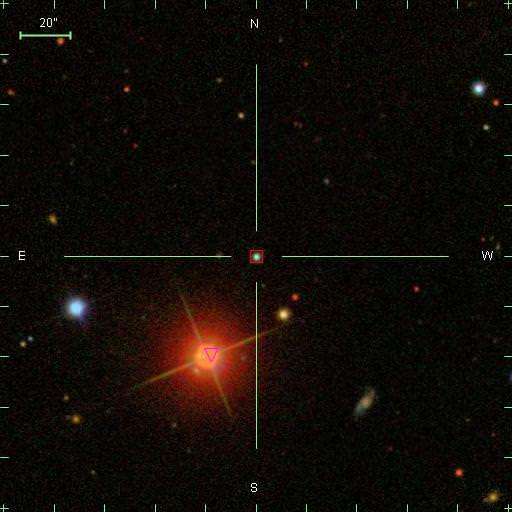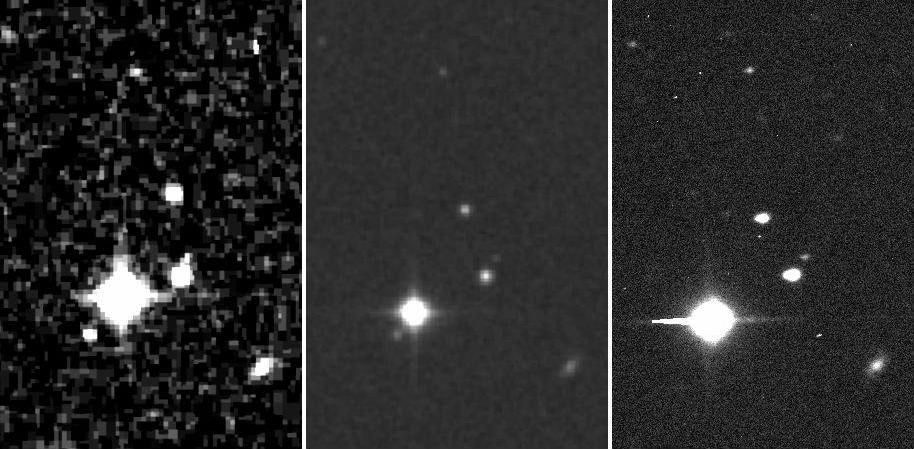[/caption]
“The most exciting phrase to hear in science, the one that heralds new discoveries, is not Eureka! (I found it!) but rather, ‘hmm… that’s funny…'” (Isaac Asimov)
A few short years ago, Zooite Hanny van Arkel discovered Hanny’s Voorwerp in an SDSS image of a galaxy (“What’s the blue stuff below? Anyone?”), and a new term entered astronomers’ lexicon (“voorwerpje”).
Very late last year, Zooite mitch too had a ‘that’s funny…’ moment, over a spectrum (yes, you read that right, a spectrum!).
Now neither Hanny nor mitch have PhDs in astronomy …

But I digress; what, exactly, did mitch discover? Judge for yourself; here’s the spectrum of the star in question (it goes by the instantly recognizable name 587739406764540066):

“I asked a couple of white-dwarf aficionados, and neither recalls seeing any star with these features (nor does Jim Kaler, who wrote the book on stellar spectra),” Bill Keel, a Zooite Astronomer known as NGC3314 wrote, kicking off a flurry of forum posts, and a most interesting discussion!
“Can we rule out something along the line of sight, possibly a cold molecular cloud?” EigenState wrote; “If both stars are moving SE (towards the bottom left corner), could Mitch’s star (square) be affected by debris in the trail of the bright red star (triangle)? I am thinking of the trail left by Mira. So the spectrum would be white dwarf shining through cooled red star debris?” said Budgieye. NGC3314 continued “It can’t be like our current Oort Cloud since we don’t see local absorption from our own in front of lots of stars near the ecliptic plane. To show up this strongly, it would then have to be either much denser or physical much smaller. This just in – this may be the most extreme known example of a DZ white dwarf, which have surface metals. White dwarfs aren’t supposed to, because their intense surface gravity will generally sort atmospheric atoms by density, so this has been suggested (with some theoretical backing) to result from accretion either from circumstellar or interstellar material (so it could be at the star’s surface but representing material formerly in a surrounding disk). Watch this space…”
Then, two weeks after mitch’s discovery, Patrick Dufour, of the Université de Montréal, joined in “Hi everyone, I have known this objects for many years. I have done fits almost 5 years ago but just never took time to publish it. Will do it in the next few weeks. Meanwhile, enjoy this preliminary analysis… The abundances are very similar to G165-7, the magnetic DZ, but it’s a bit cooler (explaining the strength of the features).” Patrick, as you might have guessed from this, is an astronomer with specific expertise in white dwarfs; in fact the abstract to his PhD thesis begins with these words “The goal of this thesis is to accurately determine the atmospheric parameters of a large sample of cool helium-rich white dwarfs in order to improve our understanding of the spectral evolution of these objects. Specifically, we study stars showing traces of carbon (DQ spectral type) and metals (DZ spectral type) in their optical spectrum.”
Somehow yet another astronomer, Fergal Mullally heard about mitch’s mystery star and joined in too “Many other WDs with strong metal absorption lines are surrounded by a cloud of accretable material. This makes sense because the metals quickly sink below the surface (as mentioned by NGC3314). In some cases, metals are only visible for a few weeks before they are sink too deep to be seen. The disks are exciting, not only because they can be so young, but their composition suggests we might be looking at the remains of an asteroid belt (see http://arxiv.org/abs/0708.0198).” To which Patrick added “Mitch’s Mystery Star is a cool (~4000-5000 K) helium rich white dwarf with traces of metals (abundances similar to G165-7). The metals most probably originate from a tidally disrupted asteroid or minor planet that formed a disk around the star.”
So, mitch’s mystery star is just a rather weird kind of DZ star, and DZs are just unusual white dwarfs?
Yes … and no. “The asymmetrical line near 5000 is almost certainly MgH. As for the one at 6100, I am open to suggestion. I have never seen it anywhere else. For G165-7, the splitting is Zeeman. But the broadening is van der Waals by neutral helium. No splitting is observed in this star (and I took a really good spectra at MMT a few years ago to be sure).” Patrick again; so what is the mysterious asymmetrical line at 6100 Å?
Two more weeks passed, and a possible reason for Fergal’s interest emerges, in a post by NGC3314 “While we wait to see how Patrick’s new calculation shakes out, here’s an interesting new manuscript he was involved with, that points to likewise interesting things about the DZ stars. [] Wow. White-dwarf spectra as tombstones for planetary systems… wonder how the system stayed close enough to end up on the white-dwarf atmosphere all through the red-giant phases? The binary systems we can see look awfully far apart to have had helpful dynamical effects for this.” (in case you didn’t read up on Fergal, he’s very keen on exoplanets and ET).

Then, in February, a tweet: “At campus observatory, seeing whether we can measure orbital motion between Mitch’s star and its K-dwarf companion.” The tale is becoming curiouser and curiouser (exoplanets in binary star systems? If life had evolved on a planet in orbit around the star which later went red giant then white dwarf, could it have somehow survived and landed on a planet in orbit around the K-dwarf companion?)
I’ll let NGC3314 have the final word: “This furnishes one more example of how the wide interest in Galaxy Zoo allows things once unthinkable – during the SDSS, the whole analysis plan never conceived that every bright galaxy in the survey, and every one of the million or so spectra would actually be examined by a human being.”
Oh, and the Asimov quote seems to be an urban myth (if any reader knows when, and where, Asimov actually said, or wrote, those words …).
Source: Galaxy Zoo Forum thread Mitch’s Mystery Star
Full caption for image at the top of this article (Credit: Bill Keel):
I had a look with the SARA 1m telescope in BVR filters last week, to check for obvious variability. Pending more exact measurements, it’s about as bright as it was in the SDSS images and the older Palomar plates. As SIMBAD shows, this is known as a star of fairly high proper motion (and that’s about all). You can see this when I register the original red-light Palomar photograph to the image from last week, a time span of almost 59 years. The attached picture compares red-light data from the original Palomar Schmidt sky survey in early 1951, the second-epoch Palomar survey around 1990, and SARA on Jan. 7, 2010. You can also see that the bright red star to the southeast has almost exactly the same (large) proper motion.


Perplexing. I didn’t browse all of the thread, but someone noted that the surface temperature is a tad high for diatomic rotational spectra. Yet those asymmetric bands look suspiciously like the only molecular band I’ve had reason to look at. (Cold plasma discharge N2 3914 Å molecular band.)
[So they are discussing metal hydrides, but also collisional broadening mechanisms of which I know nothing. The former I can accept readily, the later needs a selective mechanism but apparently has. Wow, imagine that!]
Can anyone point me at some introductory material on stellar spectra and their origins, not too basic – maybe at undergraduate level? I’ve always wanted to know more about this subject.
What’s missing in this story is what exactly is so strange about the spectrum. The story contains a lot of jargon and seems to assume that the picture of the spectrum by itself shows that something strange is going on.
I guess that most readers of Universe Today are not experts in stellar spectra, so a bit more explanation would have been useful.
I can make a few guesses as to the identity of the mysterious spectral line at around 6,125A.
*Ca I: has a strong line at 6,122
*Ne I: lots of strongish lines around 6,100
*Si II: Line at 6125
Calcium and silicon are consistent with the hypothesis that there is rocky junk orbiting the star. Neon would only really be plausible if this was the kind of star that produced it in nuclear burning.
I think the Asimov quote appeared in “Far As Human Eye Could See,” one of the good doctor’s collections of science essays published in 1986. I’ve just ordered a fresh copy so I can check and I’ll let you know for sure. I’ve noticed over the years that my copies of Asimov seem to have a high vapor pressure. (They evaporate quickly.) I hope this means my students simply forgot to bring them back because they found the stories so engrossing.
For those interested in an introduction to astronomical spectroscopy, I recommend the Project CLEA computer lab exercise on stellar spectra available online from Gettysburg College at http://www3.gettysburg.edu/~marschal/clea/CLEAhome.html These lab exercises are revised and updated versions of the old Sky and Telescope laboratory exercises for undergraduate students.
If I glazed-over reading of the jargon was correct, what we are seeing in the spectra is the remains of some kind of large, rocky body that recently impacted the white dwarf star?
Jesper,
I agree.
If, one day, I am able to explain what’s exciting about a spectrum like the one in my article (from SDSS), in a thousand words or so, in a way that someone who knows next to nothing about spectra (in general, not just astronomical ones) can easily appreciate, I will be a very, very happy camper! In fact, I may even regard it as a high point of my entire life.
So, to anyone reading this: advice, assistance, suggestions, etc please … I promise to read them very carefully, and give you full credit for any future success, based on them, that I may have!
And by the way, just to let you know I’m working, off and on, on how to explain the modest number of key parameters in the ‘Big Bang theory’ (a.k.a. LCDM models) in a way that someone without a university degree in physics can readily grasp. It’s tough, very tough.
What I love about this story is that clearly people not connected to major funding are making interesting discoveries as we learn more details about the universe around us… in this case more about a subset of old White Dwarf stars.
Concerning Mark’s question of a few minutes ago, I believe it is not an impact from a rocky body as much as debris falling in from a ring that used to be a rocky body. If it had been an impact the spectrum would be changing very rapidly (weeks).
Rob_Bowman,
Zooite EigenState, who’s been active in the Galaxy Zoo forum thread (and who I quoted in my article), has a couple of introductions that might be close to what you’re after. They’re easy to find … simply click on the links in his sig!
Just a quick update about the Asimov quote.
BillGawne has a lead (see above); does anyone have a copy of “Far As Human Eye Could See”?
And ngc3314 wrote, over in the BAUT forum “I remember that line from Asimov from many years ago”, but hasn’t tracked it down yet (apparently).
So, it’s still a bit of a mystery …